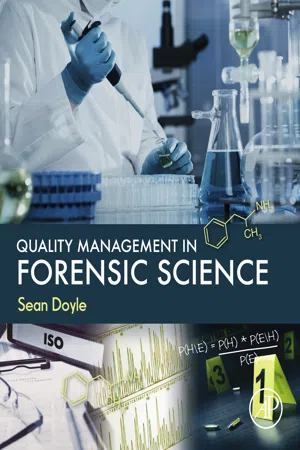
- 426 pages
- English
- ePUB (mobile friendly)
- Available on iOS & Android
Quality Management in Forensic Science
About this book
Forensic science has been under scrutiny for some time, since the release of the NAS report in 2009. The report cited the need for standardized practices and the accreditation of crime labs. No longer can the forensic community take the position that cross-examination in a courtroom will expose weaknesses in methodology and execution.Quality Management in Forensic Science covers a wide spectrum of forensic disciplines, relevant ISO and non-ISO standards, accreditation and quality management systems necessary in any forensic science laboratory. Written by a globally well-respected forensic scientist with decades of experience in the forensic science laboratory and on the stand, as an expert witness who is also a Fellow of both the Royal Society of Chemistry and the Chartered Society of Forensic Sciences. This book will be a must-have resource for all forensic science stakeholders, particularly law enforcement agents and lawyers less familiar with the impact of quality management on the reliability of scientific evidence.- A comprehensive, multidisciplinary reference of scientific practices for use in the forensic laboratory- Coverage from DNA to toxicology, from trace evidence to crime scene and beyond- Extensive review of ISO and non-ISO standards, accreditation, QMS and much more- Written by a foremost forensic scientist with decades of experience in the laboratory and as an expert witness
Frequently asked questions
- Essential is ideal for learners and professionals who enjoy exploring a wide range of subjects. Access the Essential Library with 800,000+ trusted titles and best-sellers across business, personal growth, and the humanities. Includes unlimited reading time and Standard Read Aloud voice.
- Complete: Perfect for advanced learners and researchers needing full, unrestricted access. Unlock 1.4M+ books across hundreds of subjects, including academic and specialized titles. The Complete Plan also includes advanced features like Premium Read Aloud and Research Assistant.
Please note we cannot support devices running on iOS 13 and Android 7 or earlier. Learn more about using the app.
Information
Brief Introduction to Some Important Concepts and Key Terms
Abstract
Keywords
1.1. Introduction
- • Science,
- • Quality,
- • Metrology, and
- • Cognitive bias.
1.2. Science
1.2.1. Science
- 1. a body of knowledge; e.g., the science of chemistry, and
- 2. a method of enquiry; to find out about the universe.

1.2.2. Forensic Science
Table of contents
- Cover image
- Title page
- Table of Contents
- Copyright
- Copyright and Permissions
- Dedication
- Foreword
- Acknowledgments
- Acronyms and Abbreviations
- Terms and Definitions
- Introduction
- Table of Cases Referred to in the Text
- Some Important Events in the Development of Quality Management in Forensic Science
- Section 1. Brief Introduction to Some Important Concepts and Key Terms
- Section 2. Organizations Exercising Responsibility for Quality Management in Forensic Science
- Section 3. An Introduction to the Standards Applicable to the Management, Practice, and Delivery of Forensic Science
- Section 4. Historical Perspective: Significant Events/Steps in the Development of Quality Management in Forensic Science
- Section 5. Current Practice: The Practical Application of Quality Management
- Section 6. Discipline-Specific Quality Management
- Section 7. Current Issues
- Appendix A. International Association for Identification: Code of Ethics and Standards of Professional Conduct
- Appendix B. Forensic Science Regulator: Code of Conduct for Forensic Science Practitioners
- Appendix C. The National Code of Professional Responsibility for Forensic Science and Forensic Medicine Service Providers (USA)
- Appendix D. American Academy of Forensic Sciences: Code of Ethics and Conduct
- Appendix E. Australia and New Zealand Forensic Science Society: Code of Professional Practice
- Appendix F. The Criminal Procedure Rules Part 19 (Applying in England and Wales)
- Appendix G. Council for the Registration of Forensic Practitioners: Required Competencies
- Appendix H. UK Forensic Science Liaison Group: Code of Practice
- Appendix I. New Zealand Code of Conduct for Expert Witnesses
- Appendix J. Criminal Practice Directions Parts 19A and B (Applying in England and Wales)
- Appendix K. A Selection of Important Works Recommended for Further Reading
- Key Quality Standards Applying to the Management and Delivery of Forensic Science
- Index